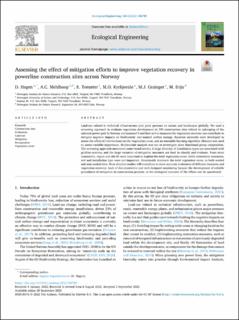| dc.contributor.author | Hagen, Dagmar | |
| dc.contributor.author | Mehlhoop, Anne Catriona | |
| dc.contributor.author | Torsæter, E. | |
| dc.contributor.author | Kyrkjeeide, Magni Olsen | |
| dc.contributor.author | Grainger, Matthew | |
| dc.contributor.author | Evju, Marianne | |
| dc.coverage.spatial | Norway | en_US |
| dc.date.accessioned | 2022-10-18T11:10:38Z | |
| dc.date.available | 2022-10-18T11:10:38Z | |
| dc.date.created | 2022-10-12T12:47:36Z | |
| dc.date.issued | 2022 | |
| dc.identifier.issn | 0925-8574 | |
| dc.identifier.uri | https://hdl.handle.net/11250/3026636 | |
| dc.description.abstract | Land-use related to technical infrastructure puts great pressure on nature and landscapes globally. We used a screening approach to evaluate vegetation development in 295 construction sites related to upkeeping of the national power grid in Norway and assessed if and how active measures for vegetation recovery can contribute to mitigate negative impacts on biodiversity and natural carbon storage. Bayesian networks were developed to assess the effect of interventions on the vegetation cover, and an ensemble learning algorithm (Boruta) was used to assess variable importance. Multivariate analysis was run to investigate plant functional group composition. The screening approach uncovered some broad results; A large diversity of installation types are associated with gridline-systems, and the large variation of mitigation measures are hard to classify and evaluate. Years since restoration, region and site ID were important to explain the total vegetation cover, while restoration treatment, soil and installation type were not important. Graminoids dominate the total vegetation cover, in both seeded and non-seeded sites. More detailed studies will contribute to more accurate evaluation of different measures and vegetation recovery. Lack of documentation and well-designed monitoring hamper the development of reliable procedures of mitigation in construction projects, as the ecological outcome of the efforts can be questioned.e efforts of municipalities and tour operators to develop sustainable local nature-based tourism products, particularly in remote areas. Construction sites Evaluation Land-use Mitigation Revegetation Vegetation cover | en_US |
| dc.language.iso | eng | en_US |
| dc.rights | Navngivelse 4.0 Internasjonal | * |
| dc.rights.uri | http://creativecommons.org/licenses/by/4.0/deed.no | * |
| dc.subject | Construction sites | en_US |
| dc.subject | Evaluation | en_US |
| dc.subject | Land-use | en_US |
| dc.subject | Mitigation | en_US |
| dc.subject | Revegetation | en_US |
| dc.subject | Vegetation cover | en_US |
| dc.title | Assessing the effect of mitigation efforts to improve vegetation recovery inpowerline construction sites across Norway | en_US |
| dc.title.alternative | Assessing the effect of mitigation efforts to improve vegetation recovery inpowerline construction sites across Norway | en_US |
| dc.type | Peer reviewed | en_US |
| dc.type | Journal article | en_US |
| dc.description.version | publishedVersion | en_US |
| dc.rights.holder | © 2022 The Authors | en_US |
| dc.subject.nsi | VDP::Miljøteknologi: 610 | en_US |
| dc.subject.nsi | VDP::Environmental engineering: 610 | en_US |
| dc.subject.nsi | VDP::Miljøteknologi: 610 | en_US |
| dc.subject.nsi | VDP::Environmental engineering: 610 | en_US |
| dc.source.volume | 184 | en_US |
| dc.source.journal | Ecological Engineering: The Journal of Ecotechnology | en_US |
| dc.identifier.doi | 10.1016/j.ecoleng.2022.106789 | |
| dc.identifier.cristin | 2060821 | |
| dc.relation.project | Norges forskningsråd: 282327 | en_US |
| dc.relation.project | Andre: Statnett | en_US |
| dc.source.articlenumber | 106789 | en_US |
| cristin.ispublished | true | |
| cristin.fulltext | original | |
| cristin.qualitycode | 1 | |

